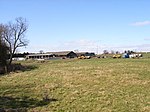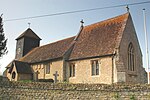Stadhampton
Civil parishes in OxfordshireUse British English from August 2015Villages in Oxfordshire

Stadhampton is a village and civil parish about 7 miles (11 km) southeast of Oxford in South Oxfordshire, England. Stadhampton is close to the River Thame, a tributary of the River Thames. The village was first mentioned by name in 1146, and was in the ownership of the bishops of Lincoln, the crown, and various Oxford colleges for most of subsequent history. The village includes several buildings of historical and architectural interest, including a parish church with features dating back to the 12th-century.
Excerpt from the Wikipedia article Stadhampton (License: CC BY-SA 3.0, Authors, Images).Stadhampton
Newells Close, South Oxfordshire
Geographical coordinates (GPS) Address Nearby Places Show on map
Geographical coordinates (GPS)
| Latitude | Longitude |
|---|---|
| N 51.68 ° | E -1.13 ° |
Address
Newells Close
Newells Close
OX44 7XS South Oxfordshire
England, United Kingdom
Open on Google Maps









